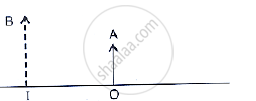Advertisements
Advertisements
प्रश्न
When a ray of light enters from one medium to another having different optical densities it bends. Why does this phenomenon occur?
उत्तर
When a ray of light enters from one medium to another with different optical densities, it bends because there is a change in the speed of light in the two media.
APPEARS IN
संबंधित प्रश्न
Describe with the help of a ray-diagram, the size, nature and position of the image formed by a convex lens when an object is placed beyond 2f in front of the lens.
What type of lens is shown in the diagram on the right? What will happen to the parallel rays of light? Show by completing the ray diagram.
Find the nature, position and magnification of the images formed by a convex lens of focal length 0.20 m if the object is placed at a distance of:
0.15 m
An object is placed 20 cm from (a) a converging lens, and (b) a diverging lens, of focal length 15 cm. Calculate the image position and magnification in each case.
An image formed on a screen is three times the size of the object. The object and screen are 80 cm apart when the image is sharply focussed.
State which type of lens is used.
Define the term principal axis of a lens.
Where is the image formed?
The given below figure shows an object OA and its image IB formed by a lens
. 
draw suitable rays to locate the lens and its focus.
For finding the focal length of a convex lens by obtaining the image of a distant object, one should use as the object.
(1) a well lit distant tree
(2) window grill in the class room
(3) any distant tree
(4) a lighted candle kept at the other end of the table.
Out of the two lenses one concave and the other convex state which is a convergent or a divergent type of a lens. Give a reason for your answer.
